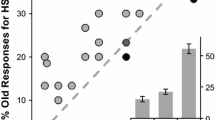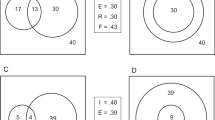Abstract
A yes-no recognition task and two recall tasks were conducted using pictures of high and low familiarity ratings. Picture familiarity had analogous effects to word frequency, and replicated the word-frequency paradox in recall and recognition. Low-familiarity pictures were more recognizable than high-familiarity pictures, pure lists of high-familiarity pictures were more recallable than pure lists of low-familiarity pictures, and there was no effect of familiarity for mixed lists. These results are consistent with the predictions of the Search of Associative Memory (SAM) model.
Similar content being viewed by others
References
Allen, L. R., & Garton, R. F. (1968). The influence of word knowledge on the word-frequency effect in recognition memory. Psychonomic Science, 10, 401–402.
Balota, D. A., & Neely, J. H. (1980). Test-expectancy and word-frequency effects in recall and recognition. Journal of Experimental Psychology: Human Learning and Memory, 6, 576–587.
Battig, W. F., & Montague, W. E. (1969). Category norms for verbal items in 56 categories: A replication and extension of the Connecticut category norms. Journal of Experimental Psychology Monograph, 80 (3, Pt. 4).
Bousfield, W. A., & Cohen, B. H. (1955). The occurrence of clustering in the recall of randomly arranged words of different frequencies-of-usage. Journal of General Psychology, 52, 83–95.
Clark, S. E., & Burchett, R. E. R. (1994). Word frequency and list composition effects in associative recognition and recall. Memory and Cognition, 22, 55–62.
Dahl, H. (1979). Word frequency of spoken American English. Essex, CT: Verbatim.
Deese, J. (1960). Frequency of usage and number of words in free recall: The role of association. Psychological Reports, 7, 337–344.
Delosh, E. L., & McDaniel, M. A. (1996). The role of order information in free recall: Application to the word-frequency effect. Journal of Experimental Psychology: Learning, Memory, and Cognition, 22, 1136–1146.
Dewhurst, S. A., Hitch, G. J., & Barry, C. (1998). Separate effects of word frequency and age of acquisition in recognition and recall. Journal of Experimental Psychology: Learning, Memory, and Cognition, 24, 284–298.
Dobbins, I. G., Kroll, N. E. A., Yonelinas, A. P., & Liu, Q. (1998). Distinctiveness in recognition and free recall: The role of recollection in the rejection of the familiar. Journal of Memory and Language, 38, 381–400.
Duncan, C. P. (1974). Retrieval of low-frequency words from mixed lists. Bulletin of the Psychonomic Society, 4, 137–138.
Gillund, G., & Shiffrin, R. M. (1984). A retrieval model for both recognition and recall. Psychological Review, 91, 1–67.
Glanzer, M., & Adams, J. K. (1985). The mirror effect in recognition memory. Memory and Cognition, 13, 8–20.
Glanzer, M., & Adams, J. K. (1990). The mirror effect in recognition memory: Data and theory. Journal of Experimental Psychology: Learning, Memory, and Cognition, 16, 5–16.
Glanzer, M., & Bowles, N. (1976). Analysis of the word-frequency effect in recognition memory. Journal of Experimental Psychology: Human Learning and Memory, 2, 21–31.
Glanzer, M., Adams, J. K., & Iverson, G. (1991). Forgetting and the mirror effect in recognition memory: Concentering of underlying distributions. Journal of Experimental Psychology: Learning, Memory, and Cognition, 17, 81–93.
Gorman, A. M. (1961). Recognition memory for nouns as a function of abstractness and frequency. Journal of Experimental Psychology, 61, 23–29.
Gregg, V. H., Montgomery, D. C., & Castano, D. (1980). Recall of common and uncommon words from pure and mixed lists. Journal of Verbal Learning and Verbal Behavior, 19, 240–245.
Guttentag, R. E., & Carroll, D. (1994). Identifying the basis for the word frequency effect in recognition memory. Memory, 2, 255–273.
Guttentag, R. E., & Carroll, D. (1997). Recollection-based recognition: Word frequency effects. Journal of Memory and Language, 37, 502–516.
Hall, J. F. (1954). Learning as a function of word-frequency. American Journal of Psychology, 67, 138–140.
Hall, J. F. (1985). Free recall as a function of type of encoding and word frequency. Bulletin of the Psychonomic Society, 23, 368–370.
Kinsbourne, M., & George, J. (1974). The mechanism of the word-frequency effect on recognition memory. Journal of Verbal Learning and Verbal Behavior, 13, 63–69.
Kintsch, W. (1970). Learning, memory and conceptual processes. New York: Wiley.
Kucera, H., & Francis, W. N. (1967). Computational analysis of present-day American English. Providence, RI: Brown University Press.
MacLeod, C. M., & Kampe, K. E. (1996). Word frequency effects on recall, recognition, and word fragment completion tests. Journal of Experimental Psychology: Learning, Memory, and Cognition, 22, 132–142.
Mandler, G., Goodman, G. O., Wilkes-Gibbs, D. L. (1982). The word-frequency paradox in recognition. Memory and Cognition, 10, 33–42.
May, R. B., & Tryk, H. E. (1971). Word sequence, word frequency, and free recall. Canadian Journal of Psychology, 24, 299–304.
May, R. B., Cuddy, L. J., & Norton, J. M. (1979). Temporal contrast and the word frequency effect. Canadian Journal of Psychology, 33, 141–147.
McCormack, P. D., & Swenson, A. L. (1972). Recognition memory for common and rare words. Journal of Experimental Psychology, 95, 72–77.
Murdock, B. B., Jr. (1960). The immediate retention of unrelated words. Journal of Experimental Psychology, 60, 222–234.
Otani, H., & Whiteman, H. L. (1993). Word frequency effect: A test of processing-based explanation. Psychological Record, 43, 317–327.
Raaijmakers, J. G., & Shiffrin, R. M. (1981). Search of associative memory. Psychological Review, 88, 93–134.
Rao, K.V. (1983). Word frequency effect in situational frequency estimation. Journal of Experimental Psychology: Learning, Memory, and Cognition, 9, 73–81.
Raymond, B. (1969). Short-term storage and long-term storage in free recall. Journal of Verbal Learning and Verbal Behavior, 8, 567–574.
Rosch, E., Mervis, C. B., Gray, W. D., Johnson, D. M., & Boyes-Braem, P. (1976). Basic objects in natural categories. Cognitive Psychology, 8, 382–439.
Schulman, A. I. (1967). Word length and rarity in recognition memory. Psychonomic Science, 9, 21–22.
Schulman, A. I. (1976). Memory for rare words previously rated for familiarity. Journal of Experimental Psychology: Human Learning and Memory, 2, 301–307.
Schulman, A. I., & Lovelace, E. A. (1970). Recognition memory for words presented at a slow or rapid rate. Psychonomic Science, 21, 99–100.
Shepard, R. N. (1967). Recognition memory for words, sentences, and pictures. Journal of Verbal Learning and Verbal Behavior, 6, 156–163.
Snodgrass, J. G., & Corwin, J. (1988). Pragmatics of measuring recognition memory: Applications to dementia and amnesia. Journal of Experimental Psychology: General, 117, 34–50.
Snodgrass, J. G., & Vanderwart, M. (1980). A standardized set of 260 pictures: Norms for name agreement, image agreement, familiarity, and visual complexity. Journal of Experimental Psychology: Human Learning and Memory, 6, 174–215.
Sumby, W. H. (1963). Word frequency and serial position effects. Journal of Verbal Learning and Verbal Behavior, 1, 443–450.
Underwood, B. J., & Freund, J. S. (1970). Word frequency and short-term recognition memory. American Journal of Psychology, 83, 343–351.
Van Overschelde, J. P. (2002). The influence of word frequency on recency effects in directed free recall. Journal of Experimental Psychology: Learning, Memory, and Cognition, 28, 611–615.
Wallace, W. P., & Page, K. A. (1982). Recognition test trials without distractors: A comparison of test trials and study trials on recognition and recall. Bulletin of the Psychonomic Society, 20, 245–248.
Wallace, W. P., Sawyer, T. J., Robertson, L. C. (1978). Distractors in recall, distractor-free recognition, and the word-frequency effect. American Journal of Psychology, 91, 295–304.
Ward, G., Woodward, G., Stevens, A., & Stinson, C. (2003). Using overt rehearsals to explain word frequency effects in free recall. Journal of Experimental Psychology: Learning, Memory, & Cognition, 29, 186–210.
Watkins, M. J., LeCompte, D. C., & Kim, K. (2000). Role of study strategy in recall of mixed lists of common and rare words. Journal of Experimental Psychology: Learning, Memory, and Cognition, 26, 239–245.
Whiteman, H. L., & Nairne, J. S., & Serra, M. (1994). Recognition and recall-like processes in the long-term reconstruction of order. Memory, 2, 275–294.
Yoon, C., Luo, T., Mikels, J. A., Hedden, T., Gutchess, A. H., Jiao, S., & Park, D. C. (2002). Picture norming: A cross-culturally standardized set of 260 pictures in older and younger adults: American and Chinese norms for name agreement and familiarity. Internet site of the University of Michigan Cognition and Aging Lab. Retrieved February, 2002, from http://agingmind.isr.umich.edu/ca4c.html
Zechmeister, E. B., Curt, C., & Sebastian, J. A. (1978). Errors in recognition memory task are a U-shaped function of word frequency. Bulletin of the Psychonomic Society, 11, 371–373.
Acknowledgements
The authors gratefully acknowledge the assistance of Clifford A. Larochel, Andrea J. Ardouin, and Rossanna Lee in testing the participants.
Author information
Authors and Affiliations
Corresponding author
Rights and permissions
About this article
Cite this article
Karlsen, P.J., Snodgrass, J.G. The word-frequency paradox for recall/recognition occurs for pictures. Psychological Research 68, 271–276 (2004). https://doi.org/10.1007/s00426-003-0138-5
Received:
Accepted:
Published:
Issue Date:
DOI: https://doi.org/10.1007/s00426-003-0138-5




